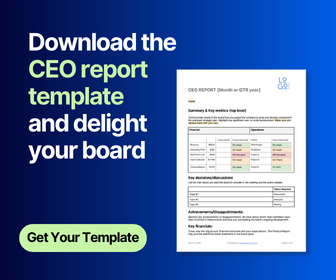Nine Tips for Running a great CEO appraisal
It is well known that many CEOs leave their employer because of a poorly executed appraisal of their performance. They also leave because of tension or disputes over performance-related payments. All Boards should ensure they have a methodical and fair approach to the CEO Appraisal. Here are some tips to help Boards and Chairs to create a more robust framework for their CEO Appraisal.
1. Decide Who will be Involved:
For fairness and balance, it is recommended that a small group from the Board undertake the CEO Appraisal, usually led by the Board Chair. Another approach we have seen is to have the Nominations and Remunerations Committee undertake it on behalf of the full Board. The Board then will endorse the Appraisal document agreed with the CEO.
2. Start Now (if you haven’t already started)!
Don’t wait until the end of the CEO Appraisal period to get started. Even if the Appraisal period has commenced, get started now!
- Talk with the CEO about their expectations of the role and the Appraisal.
- Get them to offer some possible measures they believe help to confirm the level of their performance and key achievements.
- Discuss who will be involved, what process will be used, and the timing of key events.
- Get agreement about all the above and confirm it all in a succinct email to the CEO.
- Consider recording the agreed approach in a policy/procedure so that it is not re-litigated each year or when key people change.
3. Develop Firm KPIs or Success Measures
Once you have agreed on the CEO Appraisal process, get the CEO to develop a set of draft KPIs or Success measures for their role. There should be no more than between 5 and 7 KPIs. Make sure these measures accurately reflect “what a great job looks like” in the view of the Board and CEO. Even if the Appraisal period has commenced, you can use these KPIs at the time of Appraisal to look at performance over the period.
- Make sure you have two or three KPIs relating to the achievement of the Board-approved Strategic Priorities. This will ensure they focus on the strategically important stuff and not get consumed by the day-to-day operational urgencies.
- Ensure there are a couple of KPIs that relate to operational performance. Consider measures like growth in turnover, customer or client targets, and yield on new initiatives.
- Customer or patient satisfaction can also be a great driver for improved service levels. Consider using the Net Promoter Score to set a baseline score for satisfaction, then work to improve that.
- In most human services, the safety and safeguarding of children, patients, and customers is paramount. The Board can promote a zero-tolerance approach by setting a target for a CEO KPI of zero adverse incidents in these areas.
- Staff culture and satisfaction can be an important KPI to ensure the CEO adequately supports the development of a positive culture within the organisation. You can use Net Promoter Score staff engagement and satisfaction (like customer and patient satisfaction, mentioned above).
- Find a couple of KPIs that reflect the financial health of the organisation. Meeting the Board-approved Budget should not be a KPI as that is why the CEO retains their job. Consider financial-related measures that add a bit of “stretch”. An example may be reducing corporate overheads from 24% (budget) to 19% (KPI) of total turnover.
4. Ask the CEO for their Views on their Performance and Achievements
Invite the CEO to offer their views on the performance and achievements across the Appraisal period. Invite them to link their commentary to agreed CEO KPIs. Limit them to four pages and indicate bullet points will be OK. One CEO was asked to supply this, and they submitted over 60 pages of narrative and graphs without really highlighting the achievements linked to the KPI areas!
5. Board offers their view on CEO Performance
In a page or two, the Board should offer constructive feedback to the CEO about their performance in the following areas:
- Where they have performed strongly
- Where they need to improve
- The Professional Development that would help them to improve their performance in areas identified by the Board.
6. Use a 360 Degree Feedback Process
Consider seeking 360 Degree feedback on the perceptions of the performance of the CEO. At least every few years, this can be facilitated by an external party so that respondents can openly share their views in a safe and de-identified manner. Some individuals may be reluctant to speak openly if the source of their comments may be known to the Directors or even the CEO.
- Include all direct reports for the CEO.
- Include a random sampling of staff through all levels and divisions of the organisation.
- Finally, consider including a selection of external stakeholders who have opinions that you value. These could be alliance partners, funding partners, regulatory bodies you relate to, and even the Municipal Councils where you operate.
7. Allocation of Performance-Related Payments
If you plan to offer performance-related payments to the CEO, then this should be negotiated, agreed and documented at the start of the Appraisal period. As mentioned above, this can become a source of tension or disputes when the views of the Board and CEO do not align regarding the performance of the CEO. To minimise or even eliminate prospects for tension or disputes, you should consider including the following:
- Link the payments to the five to seven CEO KPIs agreed with the CEO. The measurement against these KPIs will drive the behaviour and performance of the CEO to those areas the Board has agreed are important to the organisation.
- Set a relative weighting for the KPI areas. For example, if the Board has set a priority for growth and mergers, then this KPI area may be worth 40% of the available pool of performance payments. Some others may be important but a lower priority. They may have a weighting set at 10%. And, of course, make sure all weighted KPIs add up to 100%!
- For each KPI, the Board can rate the CEO with a percentage figure that they believe the CEO deserves for each KPI. At the outset, you should agree a framework something like this:
8. Document and Agree on the Appraisal
It surprises us that organisations still do not adequately document and agree upon the Appraisal document.
- Discuss, agree and get the CEO to sign the documentation around the Appraisal.
- If there is any area where agreement cannot be reached, you can record the view of the Board. And next to that, you can document the (dissenting) view of the CEO. It is better to reach an agreement, but if you cannot, you can still document the two different views!
9. Start Again for the Next Appraisal Period
As soon as you complete the Appraisal, set a meeting with the CEO to agree on the CEO KPIs and the Framework for the next Appraisal in around 12 months!
Templates and a CEO Appraisal Framework are available from Conscious Governance upon request. They also offer support for Boards who are time-poor and would like external support to facilitate their CEO Appraisal process.
Please, email Brendan Walsh at brendan@consciousgovernance.com for templates, advice, or consulting support.
Share this
You May Also Like
These Related Stories

Are Some of Your Board Members Missing in Action?
-3.jpg)
Why a good board needs a solid connection with the CEO
.png)

